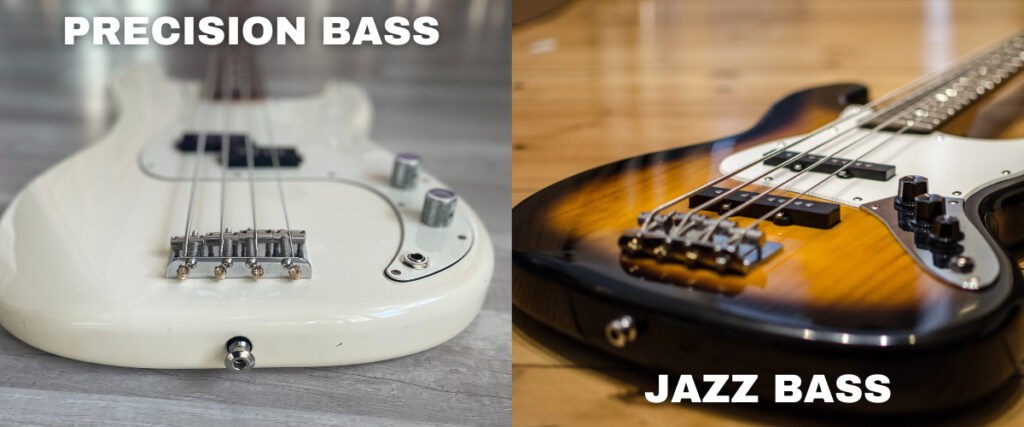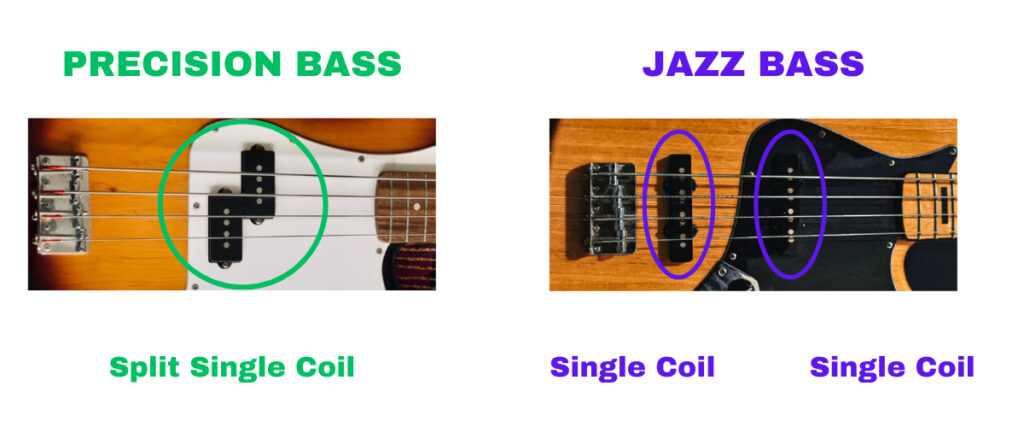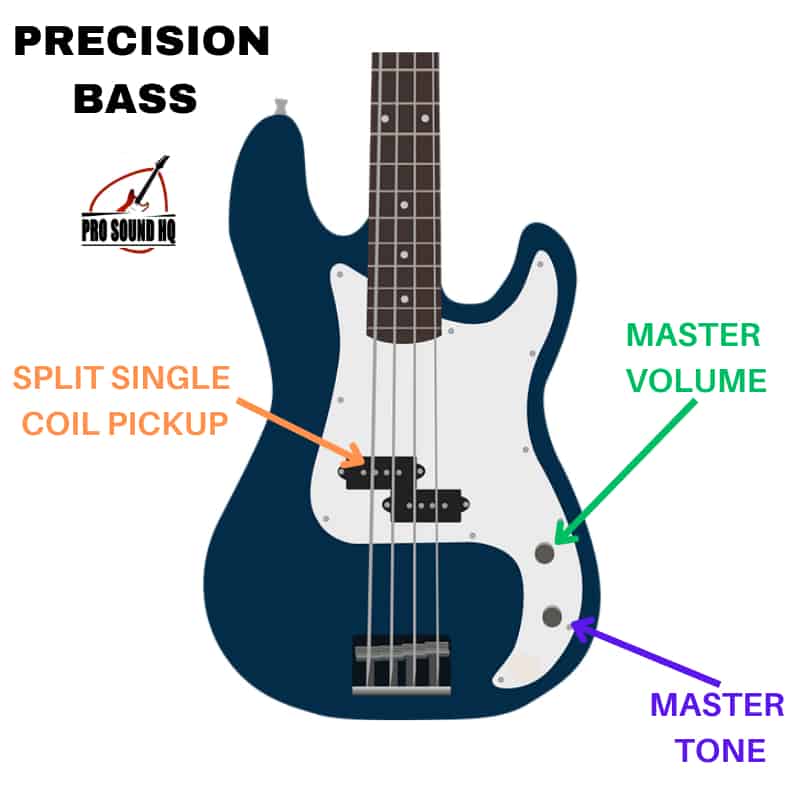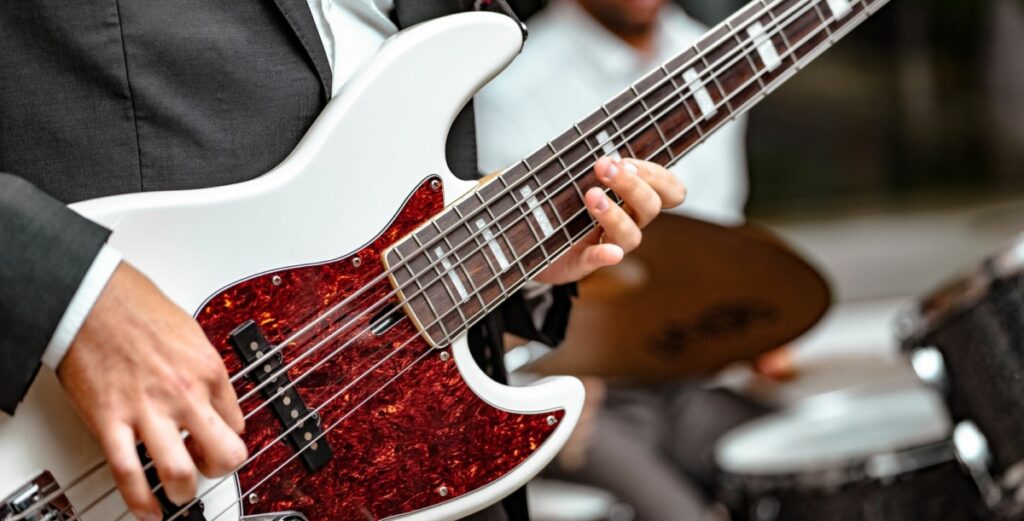The Fender J-Bass and P-Bass are two of the most iconic bass guitar models of all time. But which is the right bass for you? In this article I’ll directly compare the Jazz and Precision Bass (both Fender and Squier versions) and highlight all the differences and similarities between them so you can figure out which to choose.

The Precision bass has one split single coil pickup whereas the Jazz bass has two single coil pickups. The Precision bass sounds warmer than the Jazz bass which has more clarity. Jazz basses have a slightly narrower nut/ fretboard width but are usually slightly heavier than a Precision bass.
| Feature | Precision Bass | Jazz Bass |
| Pickups | One Split Single Coil Pickup | Two Single Coil Pickups |
| Tone | More warmth and fullness | More clarity and brightness |
| Controls | 1 x Vol, 1 x Tone | 2 x Vol, 1 x Tone |
| Body Shape | Symmetrical | Offset |
| Nut Width | 1.625″-1.75″ | 1.5″ |
| Average Weight | 8.5-9.0 lbs | 9.0-9.5 lbs |
Pickups and Tone
Precision basses have one split single coil pickup in the middle position, whereas Jazz basses have two single coil pickups in the middle and bridge positions.

Let’s first discuss the difference between split single coil and regular single coil pickups.
- The split single coil pickup on the Precision bass is wired in series which creates a hum-cancelling effect and reduces all the buzz that you’d typically get with a single coil pickup.
- With the Jazz bass, you will get some of that hum-cancelling when both single coil pickups are active, however when you are only using one pickup, you’ll notice a lot more buzz and hum.
So what about the differences between the pickups themselves (split vs regular single coil)
- The split single coil pickup on the Precision bass sounds warm and full, with more low-end emphasis
- The single coil pickups on the Jazz bass sound brighter and clearer with more treble emphasis
With the Jazz bass, you have two pickups (one closer to the neck and the other closer to the bridge). The bridge pickup sounds brighter and hotter than the neck (aka middle) pickup. This gives you some more tonal variety.
Since the P-bass only has a split single coil located closer to the neck of the bass, it naturally sounds warmer and more rounded in comparison, but lacks that top-end clarity that you’ll find on the Jazz bass.
Check out this video to hear a tone comparison of the J-bass and P-bass.
Model Variants
Although the standard pickup configurations described above are seen on most models, there is another variant of the Precision bass which has a split single coil pickup in the middle position, and a traditional single coil in the bridge.
Here is a list showing all the Precision bass models and their pickup configurations.
One Split Single Coil:
- Fender Player
- Fender Vintera
- Fender MIJ
- Fender American Professional II
- Fender American Original
- Fender American Vintage
Split Single Coil (Middle) + Single Coil (Bridge):
- Fender Player Plus
- Fender American Performer
- Fender American Ultra
Controls
Both these basses have a master tone control, however, the Jazz bass a 2 volume controls and the Precision bass has 1 volume control.
The two volume controls on the Jazz bass adjust the volume of each pickup. This means you can use them to essentially blend the pickups together. Instead of having a pickup selector which would have the pickups either on or off, the volume controls allow you to have more complex blends.

This can be really useful to create some unique tones, however, it does make it a bit of a pain to adjust mid-song if you want to quickly turn the volume of the entire bass down, as you’ll need to adjust both pickup volume controls if you have them both on.
The simplistic Precision bass controls don’t provide as much versatility, but they’re super easy to adjust. As there is only one pickup, there is only one master tone and one master volume control to consider.

Model Variants
It’s also worth noting that there are a few J bass models which have slightly different controls compared to the standard versions described above. Check out this article on Jazz bass controls to learn more.
Most P-basses have the controls described above, except for the ones with two pickups (American Ultra, Player Plus and American Performer versions) The American Ultra/ Player Plus models have active EQ controls and the American Performer has volume controls for each pickup similarly to the J-bass.
Body Shape
Although both of these basses have a double cutaway body, the Jazz Bass has an offset body whereas the Precision bass has a symmetrical body.
The Jazz bass has an asymmetrical body shape causing it to look unbalanced as the lower bout leans away from the centre of the body. The shape is also characterised by the waist being at an angle.

It really is a personal preference as to which you prefer the feel and like the look of.
Offset bodies were designed to be more comfortable and easier to sit with in a balanced position. They also tend to tilt upwards at the neck when standing, often making them easier to hold than symmetrical basses which are can sometimes feel “neck heavy”.
However, some players prefer the feel and look of a symmetrical bass. It’s also important to note that the symmetrical lower bout on the Precision bass makes it a lot easier to sit straight on a floor stand. Jazz basses will tilt awkwardly, but it’s not a problem if you prefer to hang your bass on a wall instead.
Check out this article on offset basses and guitars to learn more.
Average Weight
On average, the Jazz bass weighs slightly more than the Precision bass:
- Jazz bass = 9.0-9.5 lbs on average
- Precision bass = 8.5-9.0 lbs on average
This is because the Jazz bass has slightly more wood on the lower bout which is the thickest area of the body, hence causing it to be a slightly heavier instrument overall.
Since the difference in weight is pretty minimal, it does not make much of a difference to playability and for some will be difficult to notice.
It’s also worth noting that the exact weight of a bass can vary by usually 0.5 lbs or less when comparing two of the exact same model. So it is possible to get J and P basses that weight exactly the same as each other.

Nut Width
The Jazz Bass has a narrower fretboard/ nut width compared to the Precision Bass:
- Jazz Bass nut width = 1.5″ (38.1 mm)
- Precision Bass nut width = 1.625″-1.75″ (41.3-44.5 mm)
Jazz basses always have a relatively narrow nut width of 1.5″. The nut width on Precision basses does vary between models (e.g. Player, Vintera, American Professional etc.) but is typically either 1.625″ (on more modern versions) or 1.75″ (on vintage-inspired models).

The measurement difference doesn’t sound huge, when you consider the percentage difference it does seem more significant. The Precision bass will have a nut width which is between 8-17% (depending on the model) wider than the Precision bass. This definitely affects the feel of the instrument.
It can feel easier to play quick riffs which span over several strings on the Jazz bass because the fretboard is narrower so the strings are spaced more closely together. On the other hand, the Precision bass can make you play a bit slower particularly if you have smaller fingers.
However, there are plenty of bass players which prefer the feeling of a P-bass neck, so I’d highly encourage that you try both out in your local store to see which you like the most.
Neck Profile
It’s possible to find a variety of neck profiles and thicknesses to suit different hand sizes and positioning with both the J-bass and P-bass as there are many different model variants from both Squier and Fender. Here is a list of the different neck profiles.
C-Shape Neck
- Fender American Professional II J-Bass
- Fender American Performer J-Bass
- Fender Vintera ’70s J-Bass
- Fender Vintera ’60s J-Bass
- Fender Player Plus J-Bass
- Fender Player J-Bass
- Squier J-Bass
- Fender American Professional II P-Bass
- Fender American Vintage II 1954 P-Bass
- Fender American Vintage II 1960 P-Bass
- Fender American Performer P-Bass
- Fender Vintera ’50s P-Bass
- Fender Player Plus P-Bass
- Fender Player P-Bass
D-Shape Neck
- Fender American Ultra J-Bass
- Fender American Ultra P-Bass
U-Shape Neck
- Fender American Vintage Jazz Bass

Similarities
Despite their differences, there are also plenty of similarities between the Jazz Bass and Precision Bass including:
- 34″ scale
- Double cutaway body designs
- Typically both have an alder body and maple neck
Which Should You Choose?
I think this really comes down to which you prefer the tone of.
If you want more clarity and brightness, then go for the Jazz bass. If you want a warmer, fuller low-end then go for the Precision bass. Both are very versatile and used for a range of music styles such as rock, metal, and blues so it really is just personal preference.
The only other thing to keep in mind really is the fretboard width. If you like playing fast then the Jazz bass might feel a bit easier, but again this is personal preference so I’d highly encourage you to try out both instruments before you buy either.

Who Plays a Jazz Bass?
- John Paul Jones of Led Zeppelin
- Geddy Lee of Rush
- Flea of Red Hot Chili Peppers
- Adam Clayton of U2
- Jaco Pastorius of Weather Report
Who Plays a Precision Bass?
- Roger Waters of Pink Floyd
- Steve Harris of Iron Maiden
- Mike Dirnt of Green Day
- Nate Mendel of Foo Fighters
- Sting
Here are some more articles you might find useful:
